Small overlap front: driver-side
Rating applies to 2023-25 models
Tested vehicle: 2023 Ford Expedition XLT 4-door 4wd
The Ford Expedition was redesigned for the 2018 model year.
| Evaluation criteria | Rating |
|---|---|
| Structure and safety cage | |
| Driver injury measures | |
| Head/neck | |
| Chest | |
| Hip/thigh | |
| Lower leg/foot | |
|
Driver restraints and dummy kinematics
The dummy’s head contacted the frontal airbag but slid off the left side, leaving the head vulnerable to contact with forward structure. The side curtain airbag deployed and has sufficient forward coverage to protect the head from contact with side structure and outside objects. | |
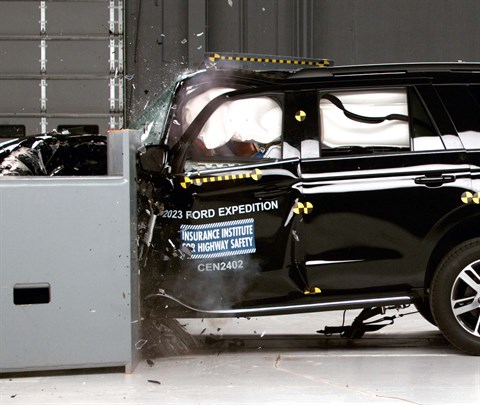
Action shot taken during the driver-side small overlap frontal crash test.
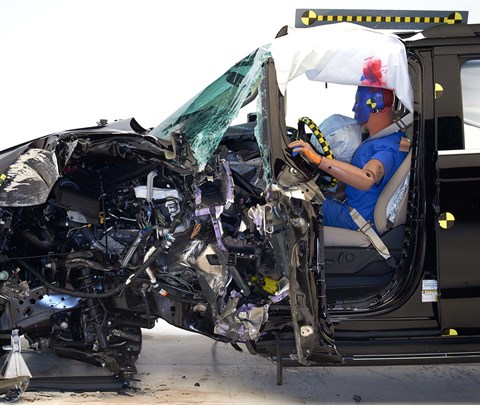
The dummy's position in relation to the door frame, steering wheel, and instrument panel after the crash test indicates that the driver's survival space was not maintained well. During the crash, the A-pillar separated completely from the rocker panel and the steering column became partially detached from the instrument panel.
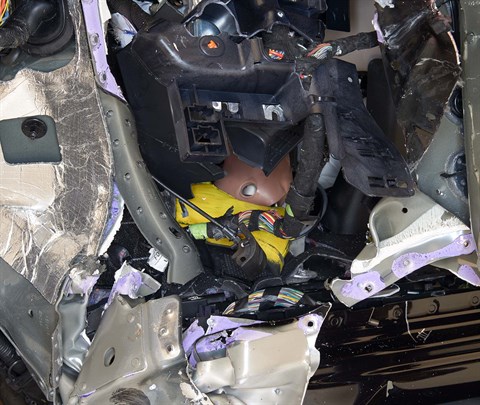
Extensive intrusion of the footrest, toepan and brake pedal contributed to a high risk of injury to the right lower leg and a moderate risk to the left lower leg.

The dummy's head contacted the frontal airbag but then slid off the left side.
Small overlap front: passenger-side
Rating applies to 2023-25 models
Tested vehicle: 2023 Ford Expedition XLT 4-door 4wd
The Ford Expedition was redesigned for the 2018 model year.
| Evaluation criteria | Rating |
|---|---|
| Overall evaluation | |
| Structure and safety cage | |
| Passenger injury measures | |
| Head/neck | |
| Chest | |
| Hip/thigh | |
| Lower leg/foot | |
| Passenger restraints and dummy kinematics | |
| Driver injury measures | |
| Head/neck | |
| Chest | |
| Hip/thigh | |
| Lower leg/foot | |
| Driver restraints and dummy kinematics | |
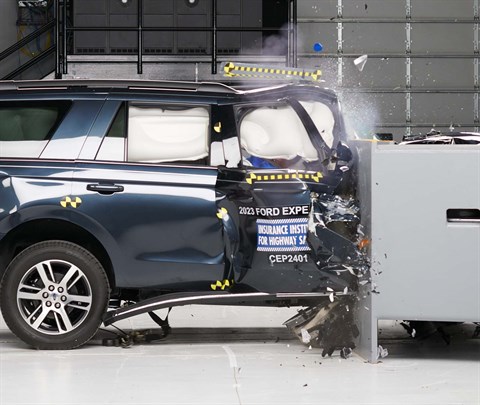
Action shot taken during the driver-side small overlap frontal crash test.
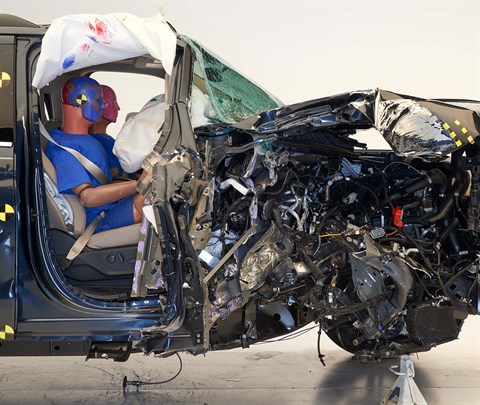
The dummy's position in relation to the door frame, steering wheel, and instrument panel after the crash test indicates that the driver's survival space was not maintained well. During the crash, the A-pillar separated completely from the rocker panel.

Extensive intrusion of the footrest and toepan contributed to a high risk of injury to the right lower leg and a moderate risk to the left lower leg.
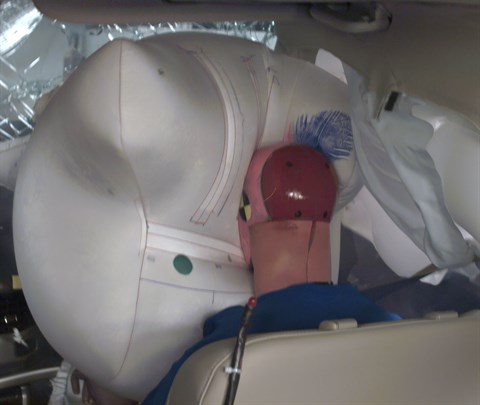
The frontal and side curtain airbags worked well together to keep the head from coming close to any stiff structure or outside objects that could cause injury.
Moderate overlap front: original test
Rating applies to 2023-25 models
Tested vehicle: 2024 Ford Expedition XLT 4-door 4wd
The Ford Expedition was redesigned for the 2018 model year.
| Evaluation criteria | Rating |
|---|---|
| Overall evaluation | |
| Structure and safety cage | |
| Driver injury measures | |
| Head/neck | |
| Chest | |
| Leg/foot, left | |
| Leg/foot, right | |
| Driver restraints and dummy kinematics | |
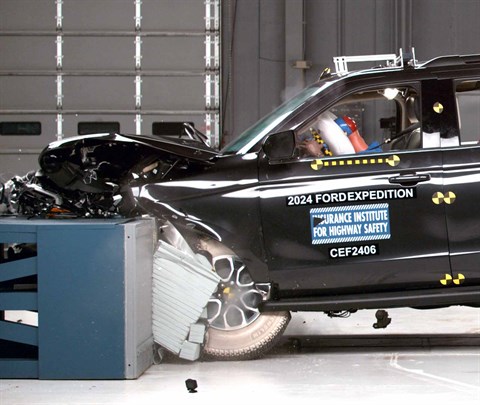
Action shot taken during the Institute's moderate overlap frontal crash test.
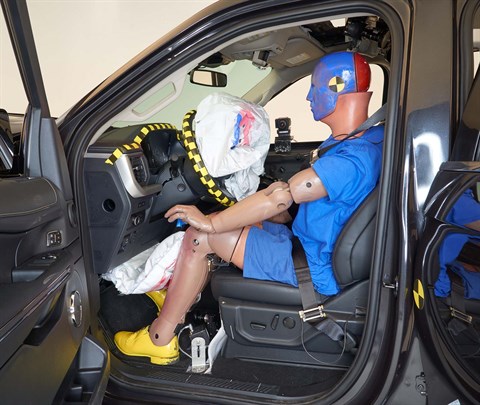
The dummy's position in relation to the steering wheel and instrument panel after the crash test indicates that the driver's survival space was maintained very well.

The driver side curtain airbag did not deploy during the crash test.
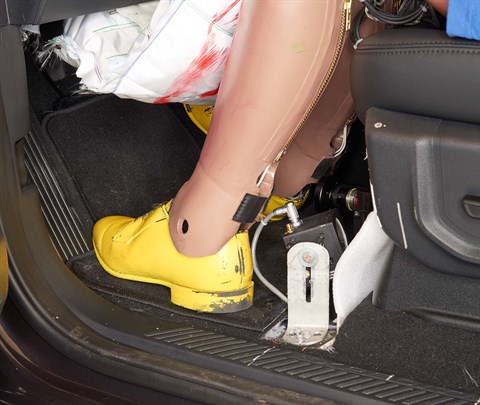
Intrusion into the driver's space was minimal, and all leg and foot injury measures were low.
Moderate overlap front: updated test
Rating applies to 2023-25 models
Tested vehicle: 2024 Ford Expedition XLT 4-door 4wd
The Ford Expedition was redesigned for the 2018 model year.
| Evaluation criteria | Rating |
|---|---|
| Overall evaluation | |
| Structure and safety cage | |
| Driver injury measures | |
| Head/neck | |
| Chest | |
| Thigh/hip | |
| Leg/foot | |
| Driver restraints and dummy kinematics | |
| Rear passenger injury measures | |
| Head/neck | |
| Chest | |
| Thigh | |
|
Rear passenger restraints and dummy kinematics
| |
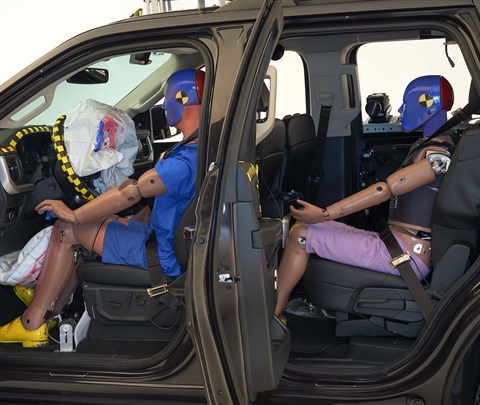
View of the vehicle after the crash showing the front driver airbags and damage to the occupant compartment. The driver and rear passenger side curtain airbags did not deploy during the test.
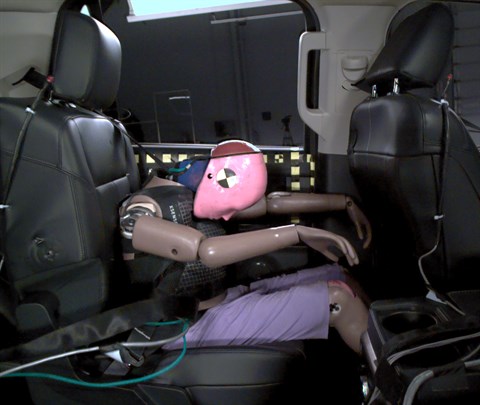
The rear passenger dummy's head remained a safe distance from the front seatback.
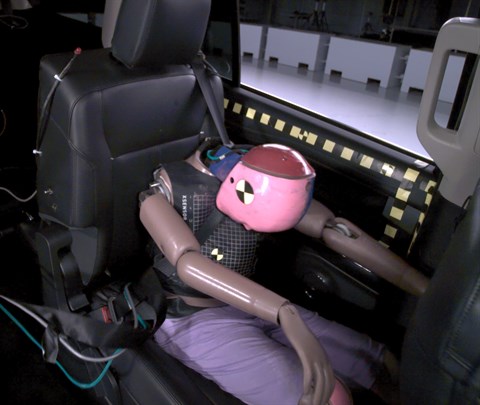
Rear passenger dummy injury values indicate a low risk of injury to the head or neck and a moderate risk of injury to the chest. During the crash, the shoulder belt remained in an ideal position on the dummy’s chest.
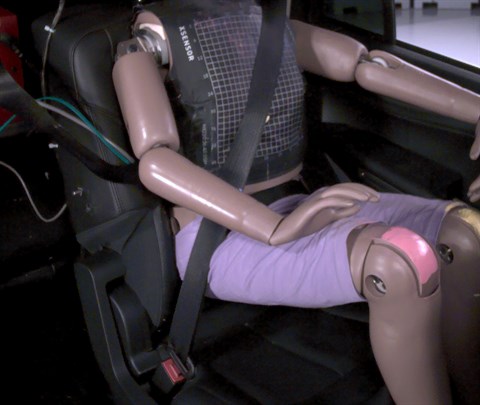
The rear passenger dummy's lap belt remained in the ideal position on the pelvis.
Side: updated test
Rating applies to 2023-25 models
Tested vehicle: 2023 Ford Expedition XLT 4-door 4wd
The Ford Expedition was redesigned for the 2018 model year.
| Evaluation criteria | Rating |
|---|---|
| Overall evaluation | |
| Structure and safety cage | |
| Driver injury measures | |
| Head/neck | |
| Torso | |
| Pelvis | |
| Driver head protection | |
| Rear passenger injury measures | |
| Head/neck | |
| Torso | |
| Pelvis | |
|
Rear passenger head protection
| |
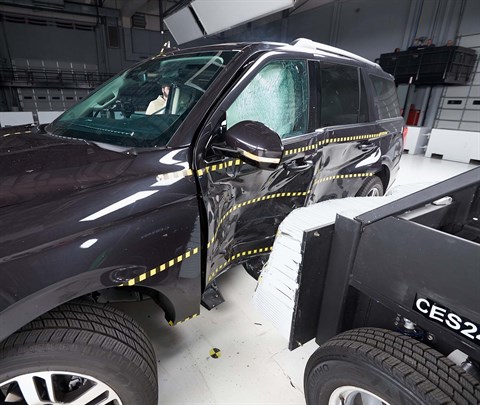
View of the vehicle just after the crash test.
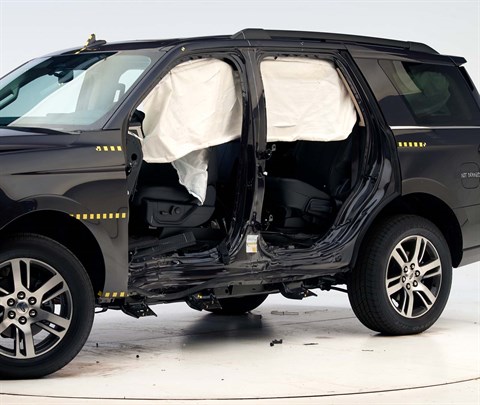
View of the vehicle after the crash with doors removed, showing the side airbags and damage to the occupant compartment.
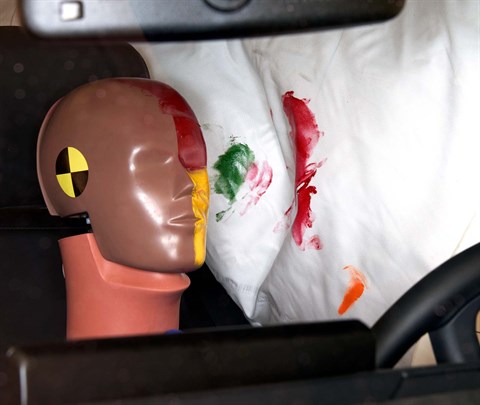
Smeared greasepaint shows where the driver dummy's head was protected from being hit by hard structures by the side airbags.

The rear dummy's head contacted the side curtain airbag hard but did not contact any hard surfaces within the occupant compartment.
Headlights
Trim level(s)
- All trims
| Evaluation criteria | Rating |
|---|---|
| Low-beam headlight type | LED reflector |
| High-beam headlight type | LED reflector |
| Curve-adaptive? | No |
| High-beam assist? | Yes |
|
Overall rating | |
| Distance at which headlights provide at least 5 lux illumination: | |
Low beams
On the straightaway, visibility was good on both sides of the road. On curves, visibility was fair on both left curves and inadequate on both right curves.
The low beams created some glare.
High beams
On the straightaway, visibility was good on both sides of the road. On curves, visibility was good on the gradual right and gradual left curves and inadequate on the sharp left and sharp right curves.
High-beam assist compensates for some limitations of this vehicle's low beams on the straightaway and all 4 curves.
Front crash prevention: vehicle-to-vehicle 2.0
Front crash prevention: pedestrian
Seat belt reminders
Rating applies to 2023 models
| Evaluation criteria | Rating |
|---|---|
| Overall evaluation | |
| Front row | |
| Unbelted occupant alert (audible & visual) | |
| Initiation time | |
| Duration | Long enough (90+ seconds) |
| Volume | |
| Audio frequency | |
| Second row | |
| Startup status alert (visual) | |
| Initiation time | |
| Duration at least 60 seconds | |
| Belt disengaged alert (audible & visual) | |
| Initiation time | |
| Duration at least 30 seconds | |
| Volume | |
| Audio frequency | |
